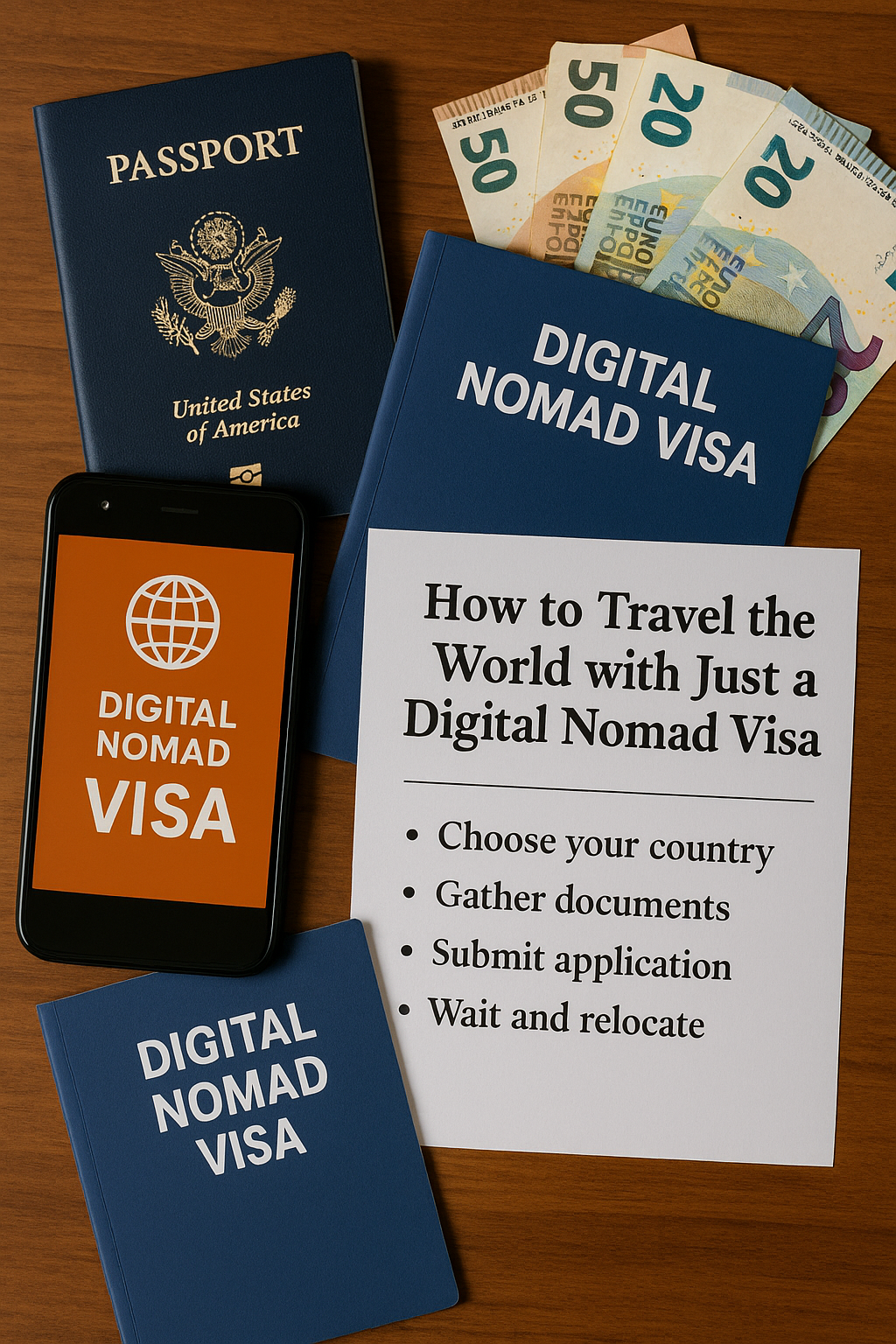Introduction: The Rise of the Borderless Worker
The traditional office is disappearing. In 2025, more people than ever are working from anywhere—with nothing but a laptop, Wi-Fi, and a dream. Enter the Digital Nomad Visa: a revolutionary solution that allows you to live legally in foreign countries while working remotely for an overseas employer or freelance clients.
This guide walks you through how to use just a digital nomad visa to travel the world in 2025. We’ll cover the top visa-friendly countries, requirements, benefits, and practical tips for living a global, location-independent life.
What Is a Digital Nomad Visa?
A digital nomad visa is a type of residency permit that allows remote workers to live in a foreign country while working for a non-local employer or clients. Unlike tourist visas, it:
- Legally allows long-term stays (usually 6–24 months)
- Doesn’t require employment in the host country
- Enables you to rent housing, open bank accounts, and access healthcare
- May lead to residency or tax benefits
Top Countries Offering Digital Nomad Visas in 2025
Here’s a breakdown of the best countries offering digital nomad visas, along with what makes each one attractive:
1. Portugal
- Visa: D7 Passive Income or Digital Nomad Visa
- Stay: 1–2 years, renewable
- Income requirement: €3,000/month
- Tax: Non-habitual resident tax benefit
2. Spain
- Visa: Digital Nomad Visa (Launched in 2023)
- Stay: 12 months, extendable up to 5 years
- Income requirement: €2,300/month (individual)
- Tax: Flat 24% rate on foreign income
3. Estonia
- Visa: Digital Nomad Visa
- Stay: Up to 12 months
- Income requirement: €4,500/month
- Pros: EU access, tech-friendly society
4. Costa Rica
- Visa: Rentista Visa / Digital Nomad Visa
- Stay: 12 months, extendable
- Income requirement: $3,000/month
- Climate: Tropical, affordable lifestyle
5. Croatia
- Visa: Digital Nomad Residence Permit
- Stay: Up to 1 year
- Income requirement: €2,300/month
- Bonus: No income tax on foreign income
6. Georgia
- Visa: Remotely from Georgia Program
- Stay: 1 year
- Income requirement: $2,000/month
- Bonus: No visa required for 90+ countries
7. Barbados
- Visa: Barbados Welcome Stamp
- Stay: 12 months
- Income requirement: $50,000/year
- Luxury island living
8. United Arab Emirates (UAE)
- Visa: Virtual Work Residence Permit
- Stay: 1 year, renewable
- Income requirement: $3,500/month
- Bonus: Dubai tech hub, 0% income tax
Common Requirements for Digital Nomad Visas
Most countries ask for the following:
- Valid passport (6+ months validity)
- Proof of remote work (employment letter or client contracts)
- Minimum income threshold (varies by country)
- Clean criminal record
- Health insurance coverage
- Proof of accommodation
Pros of Digital Nomad Visas
- Legal security: No more “visa runs” or overstays
- Tax flexibility: Many countries don’t tax foreign income
- Stability: Rent long-term housing, open accounts
- Community: Live in nomad-friendly cities like Lisbon, Tbilisi, Bali
Cons and Limitations
- Tax complexity: You might owe taxes both in your home and host country
- High income thresholds: Not all freelancers qualify
- Healthcare gaps: Not all visas grant access to public healthcare
- Paperwork load: Some countries have long processing times
How to Choose the Right Country
Ask yourself:
- Climate & Culture – Do you prefer tropical or temperate? Urban or quiet?
- Time Zone – Does it align with your clients/employer?
- Cost of Living – Can you live comfortably within your income?
- Visa Rules – Is the application simple or complicated?
Match your preferences with visa availability to make the best decision.
Step-by-Step: Applying for a Digital Nomad Visa
Step 1: Choose your country
Select based on lifestyle, income requirement, and visa length.
Step 2: Gather documents
Prepare: passport, proof of income, work contracts, insurance, rental agreements.
Step 3: Submit application
Apply through the country’s immigration website or embassy.
Step 4: Wait and relocate
Approval times vary—typically 2 to 12 weeks.
What to Do Once You Arrive
- Register with local authorities (if required)
- Open a bank account (some countries require a local address)
- Rent a co-living/co-working space
- Join local expat or digital nomad communities
- Explore and adapt!
Best Cities for Digital Nomads in 2025
| City | Country | Notable Perks |
|---|---|---|
| Lisbon | Portugal | Affordable EU hub, warm climate |
| Medellín | Colombia | Low cost, modern infrastructure |
| Tbilisi | Georgia | Visa-free, cheap, friendly |
| Tallinn | Estonia | Tech-forward, English-friendly |
| Playa del Carmen | Mexico | Beach + coworking + safety |
| Dubai | UAE | Luxury lifestyle, 0% tax |
Financial and Tax Tips
- Consider opening a multicurrency account (Wise, Revolut)
- Consult a tax advisor—some countries have tax treaties
- Keep all documents scanned and cloud-backed
- Use international health insurance
Final Thoughts
The world is your office in 2025, and a digital nomad visa is your key to borderless freedom. With careful planning, the right documents, and a clear income source, you can legally live and work from the world’s most beautiful cities—without breaking the rules.
Remote work isn’t a trend. It’s the future. And with a digital nomad visa, it’s a future you can live on your terms.
